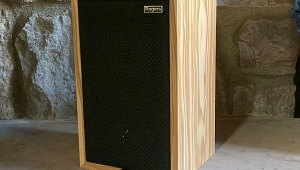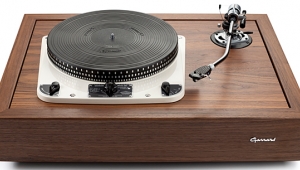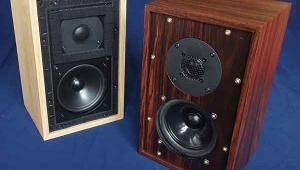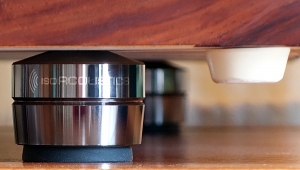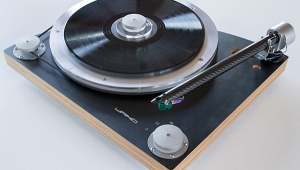| Columns Retired Columns & Blogs |
Listening #78 Page 2
The Lars Type 1 also came closer than anything I've heard to having the ideal treble performance: apparently limitless detail and air, yet without the slightest suggestion of harshness or grain. The amp had the least artificial, most natural treble performance I've ever heard from a domestic audio product of any sort. If the Lars were a speaker instead of an amplifier, it would make even the Quad ESL sound sick.
Footnote 2: One can't help seeing the parallel to popular music in the 1970s, when record labels and producers and engineers and even artists became too comfortable with the one path to success that seemed to work: excessive studio trickery, performances built around arena-sized venues, songs about wizards and fairies, saxophone solos, Michael McDonald. We traded Chuck Berry and the Kinks and the Beatles for Boston and Journey and Styx and Pablo Cruise, and rock'n'roll sucked out loud until people abandoned their old, fat, tired, wasteful ways and ultimately tried something different. And it worked—at least until those guys got old, fat, tired, wasteful...and comfortable.
The Lars Type 1's "great obligation to the beat," to use Wes Phillips' phrase, continued unabated with pop fare. The electronic percussion throughout XTC's Mummer (Japanese import CD, Toshiba-EMI TOCP 65716) was appropriately hypnotic, especially the repeating figure on the opening tune, "Beating of Hearts." Again, the Lars bowed to no other amp—literally, and regardless of output technology—in its sure grip of tempo and timing. And Jeff Buckley's Grace (CD, Columbia CK 57528) sounded simply, thoroughly amazing through the Lars: not in a superficially impressive hi-fi sort of way—the treble wasn't crisper, the bass certainly wasn't deeper—but by stripping away so many temporal distortions that the performance seemed to hold together better than it usually does, and the performers sounded more human. On "Lover, You Should Have Come Over," when the drummer enters with his kick drum, the impact was more easily felt through the system—yet at the same time, Buckley's strangely beautiful voice had even more of a secretive, insinuating quality.
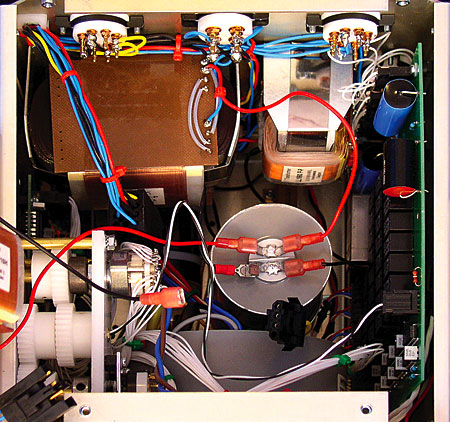
The Lars Type 1's strengths were equally evident with antique recordings, perhaps even more so. Wilhelm Furtwängler's remarkable 1949 recording, with the Vienna Philharmonic, of Wagner's Tannhäuser Overture (CD, Testament SBT 1141)—remarkable partly because no one seems to know why it wasn't released until 1998—maintained its eerily pulse-like beat better through the Lars than anything else I've had the pleasure of using. On that recording and dozens just like it, the Type 1 played music, not hi-fi. I could ask no more of a product.
Which is why I'm so puzzled that it was made to look like a whiz-bang little-boy hi-fi toy. Geez Louise, why not just build this obviously wonderful circuit into a normal box, price it to reflect a fair profit, and watch serious record lovers snap it up? Why develop such a design as this into a $100,000 product?
I can only guess. Perhaps an amplifier with this level of performance would cost $10,000 or so to manufacture—a steep but reasonable estimate, given the expense of the various transformers, switches, and metalwork required, not to mention the expense of packaging and ultimately shipping such a thing—and thus would have to sell for twice that amount in order to attract dealers and ensure profitability. But I can imagine applying to this the same axiom manifested in any number of high-end consumer goods: To many who can afford a $20,000 hi-fi component, $30,000 isn't that much of a stretch. Or $50,000. Or $100,000.
That may, in fact, be a smart marketing tactic in our present economic straits, when middle-price goods are becoming as scarce as middle-class consumers. And don't get me wrong: I'm not saying that, given the means to afford it, I would decline to buy a very expensive product, knowing that a significant portion of its price represented style as opposed to substance. But not this style.
Of the people of the unseen world
Now for that dichotomy.
Like the self-conscious teen who has trouble fitting in, I often worry that my approach to domestic audio is thoroughly, irreconcilably, and altogether unhappily out of whack with everyone else's. In my case, however, aging has made the problem worse, not better.
First: It seems that, the older I get, the less tolerance I have for conspicuous consumption in general, and for the conspicuously overstyled and altogether overcooked monuments to bad taste that pass for high-end turntables, CD transports, amplifiers, and loudspeakers in particular. And I wonder: Am I the only one who prefers audio products that are beautifully but subtly styled, that are no larger than they need to be, that are no more expensive than they need to be, and that attempt to blend with rather than dominate their surroundings? Cripes almighty, sometimes I almost think so.
Second: I firmly believe that home music systems should exist for all the people who live in the homes that have them. The fantasy paradigm that has dominated our hobby for so long—the solitary male listener in his high-tech, no-gurls-allowed spaceship of a dedicated room, with his Special Listening Chair placed just the right distance from the industry-standard giant-robot loudspeakers—has become an embarrassment, and does more to hold back our hobby than all the high prices, shopkeepers with personality disorders, and exploding amplifiers combined. Even audio reviewers' inability to "emotionally control their frequent political rantings," to quote a recent and erudite correspondent, could do us no greater damage.
Third: Setting aside SACD for a moment—which we needn't actually do, given that SACD has virtually completed the task of setting aside itself—I confess to hearing more, not less, in the way of musical differences between analog and digital playback as time goes by: differences in their abilities to convey momentum, pacing, flow, melody, harmony, and overall intellectual and emotional involvement. And, again, the older I get, the less I find I can tolerate average-quality digital sound, even for background music—even as the opposite seems to be the case among so many of my friends, and even as my hearing continues its natural and inexorable decline.
But the biggest difference between me and the rest of the audio world is this: While everyone else has been moving toward ever bigger, ever heavier, ever more inert, and, of course, ever pricier loudspeakers—which themselves require ever bigger, ever heavier, ever more inert, and ever pricier amplifiers—I have found myself traveling in the opposite direction.
That, I also confess, heavily figured in my original, positive take on the whole low-power amp thing: Virtually all of them played music well, and most of them were either cheaper than the high-end norm or were priced fairly in terms of the parts or labor costs required to make them. (The well-worn example of the Audio Note Ongaku comes to mind: a frightfully expensive amplifier, but one that was wired point-to-point and that contained several pounds of hand-extruded silver wire, not to mention handmade silver-foil capacitors, moderately rare new-old-stock tubes, and so forth.) That I tended to like the people who made those products sealed the deal.
And hey: Everyone wants to belong to something, and none more so than the ones who say they don't: the ultimate conformity of the cool. And so it was for me: Alternative audio became preferable to comparatively comfortable, bloated, and altogether unsatisfying mainstream audio (footnote 2).
Of course, it wasn't all as superficial as I make it sound, and many hobbyists were clearheaded and reasonable (if not always amicable) in the drawing of the philosophical lines that separated us. Folks in the mainstream would sometimes observe the comparatively high levels of harmonic distortion and the downright abominable degree of source-impedance sensitivity among so many SET amplifiers on the market and declare the worst of the bunch—ie, most of them—as examples of very bad engineering: a legitimate, fair, and well-founded point of view. Folks on the other side would suggest that any loudspeaker whose impedance dips below 2 ohms within its audible range, or that requires several hundred watts of amplifier power in order to play an orchestral crescendo, is just as poorly engineered—and is, in fact, something of a joke. (I confess to finding the latter products much more offensive, considering that they typically have silly prices, silly shipping weights, and silly installation requirements.) We each thought that the part we had hold of looked more like an elephant than the other guy's part.
In any event, the fallback sneer I reserved for the worst of the mainstream stuff was to write it off as thick-faceplate gear, in light of that most visible characteristic: the one that combines extremes of both uselessness and cost. And that's what disappoints me most about the beautiful-sounding Lars Type 1 from E & E Ingenjörsbyrå: It has no fewer than eight thick faceplates, none of which will even stay the hell in place.
It that sense, the Lars Type 1 was a life-changing product for me, the same as finding out that Bob Dylan wasn't really booed off that stage at Newport, that Lou Reed went home from the last Velvet Underground gig in a limo supplied by his family, that Sex Pistols impresario Malcolm McLaren was only kidding. The message being: This isn't just art, it's commerce, too. And if I happen to see some significance in a genre of hardware, some quality that allows me to think that a box of wood and wires can transcend itself and stand for something bigger, I'm just kidding myself. That baby isn't smiling at you, sir: It's just gas.
To the few who can afford it, E & E's Lars Type 1 will bring extraordinary pleasure. It may very well be the best amp I've heard—a neighborhood in which value is the traffic sign that isn't just ignored but is actually, literally unseen. To those of us who can't afford it, the Lars Type 1 is equal parts sobering and liberating: We needn't take ourselves and our world so seriously after all.
Footnote 2: One can't help seeing the parallel to popular music in the 1970s, when record labels and producers and engineers and even artists became too comfortable with the one path to success that seemed to work: excessive studio trickery, performances built around arena-sized venues, songs about wizards and fairies, saxophone solos, Michael McDonald. We traded Chuck Berry and the Kinks and the Beatles for Boston and Journey and Styx and Pablo Cruise, and rock'n'roll sucked out loud until people abandoned their old, fat, tired, wasteful ways and ultimately tried something different. And it worked—at least until those guys got old, fat, tired, wasteful...and comfortable.
- Log in or register to post comments


